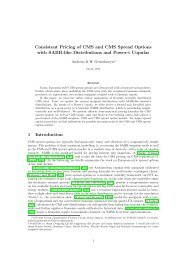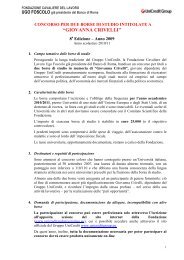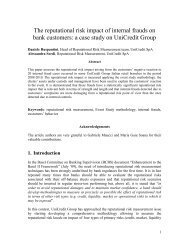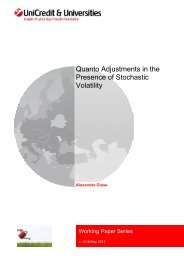Dóra Fazekas Carbon Market Implications for new EU - UniCredit ...
Dóra Fazekas Carbon Market Implications for new EU - UniCredit ...
Dóra Fazekas Carbon Market Implications for new EU - UniCredit ...
Create successful ePaper yourself
Turn your PDF publications into a flip-book with our unique Google optimized e-Paper software.
well below their Kyoto target (EEA, 2008). All <strong>new</strong> Member States were on track to meet their<br />
Kyoto target in 2004, figure 13. shows the distance to their target in percent points below their<br />
linear target path.<br />
Figure 13. Distance to Kyoto Protocol target <strong>for</strong> <strong>new</strong> Member States in 2004<br />
Source: EEA, Copenhagen, 2007<br />
Prior to 1990, the CEEs had a type of environmental policy in the <strong>for</strong>m of national quality standards<br />
and pollution permits (Skjærseth and Wettestad, 2007). After that, however, all <strong>new</strong> environmental<br />
policy principles were imported from Western neighbors. These countries are now undergoing<br />
major economic and political trans<strong>for</strong>mation, and are considered to be benefiting from emissions<br />
trading.<br />
Klepper and Peterson (2004) found that <strong>new</strong> Member States would be the only countries selling<br />
allowances, even without hot air taken into account. The authors argue that <strong>EU</strong>12 reduce the costs<br />
of reaching the European Kyoto targets considerably with their low cost abatement opportunities.<br />
According to Skjærseth and Wettestad (2007), the implementation of the <strong>EU</strong> ETS should provide<br />
the <strong>EU</strong>12 with good opportunities. Gassan-zade (2003) states that <strong>EU</strong>12 benefit from participation<br />
in the Kyoto Protocol mechanisms, either through Joint Implementation or through International<br />
Emissions Trading. All <strong>EU</strong>12 have a surplus allowances, the amount of which is estimated between<br />
696 to 1,356 Mt CO2e. “Low energy efficiency levels, high carbon intensity of the energy supply<br />
and lack of re<strong>new</strong>able energy technologies make the countries with economies in transition<br />
attractive <strong>for</strong> cost-effective GHG reduction projects under JI.” (Gassan-zade, 2003)<br />
Reinaud (2003) argued that the inclusion of accession countries to the <strong>EU</strong> ETS would reduce the<br />
cost of emissions trading by giving access to more cost-effective possibilities. As <strong>EU</strong>12 have<br />
55









